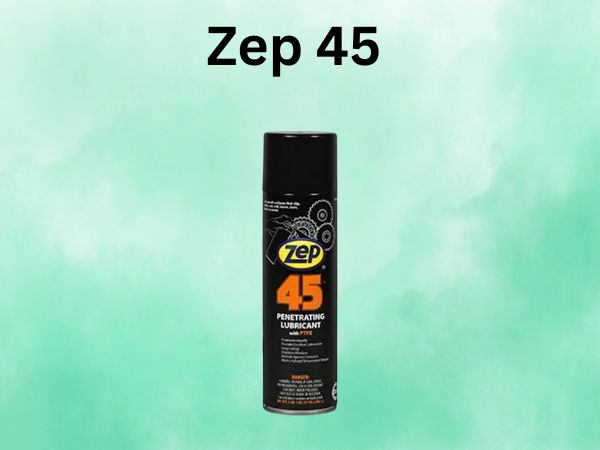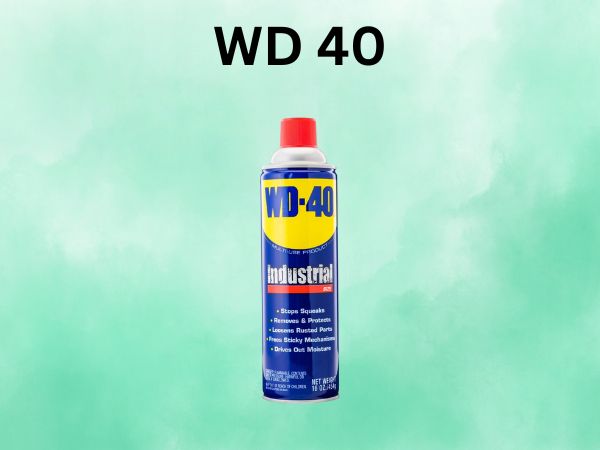Zep 45 vs WD 40 [The Ultimate Comparison]
In the world of lubricants and penetrating oils, two products have stood out as household names: Zep 45 and WD-40. Whether you’re working on a DIY project, maintaining machinery, or simply looking for a versatile solution for various tasks, understanding the differences between these two products can help you make an informed decision. In this comprehensive comparison, we’ll dive deep into the features, applications, and performance of Zep 45 and WD-40, allowing you to choose the best option for your needs.
Table of Contents
Here’s an in-depth comparison table for Zep 45 vs WD-40:
| Feature | Zep 45 | WD-40 |
| Product Type | Non-flammable penetrating lubricant | Multi-purpose lubricant, penetrant, moisture displacer |
| Primary Function | Lubrication and protection of moving parts | Lubrication, penetration, protection, removal, and moisture displacement |
| Price | Check Latest Price | Check Latest Price |
| Formulation | Polytetrafluoroethylene (PTFE) | Proprietary blend (no silicone, kerosene, water, graphite, or CFCs) |
| Lubrication Performance | Excellent long-lasting lubrication with continuous wear-resistant film | Temporary lubrication, requires frequent reapplication |
| Penetration Ability | Superior penetration for stuck and corroded parts | Good penetration for loosening stuck parts |
| Corrosion Protection | Excellent long-term protection with wear-resistant film | Temporary rust and corrosion protection |
| Versatility | Specialized for automotive, machinery, and heavy-duty applications | Highly versatile with over 2,000 reported uses |
| Safety | Non-flammable formulation | Generally safe, but flammable |
| Environmental Impact | No specific environmental claims | Formulated without certain chemicals like silicone and CFCs |
| Availability | Limited availability, typically industrial/professional channels | Widely available in retail stores and online |
| Typical Applications | Automotive repairs, machinery maintenance, freeing stuck parts, lubricating moving parts | Lubricating tools, hinges, and household items, cleaning, degreasing, moisture displacement |
| User Reviews | Praised for exceptional penetration and lubrication, corrosion removal, and winter preparation | Praised for versatility, ease of use, rust prevention, and cleaning abilities |
| Pros | Long-lasting protection, non-flammable, superior penetration and lubrication | Versatile, widely available, effective for temporary lubrication and cleaning |
| Cons | Limited availability, more expensive, specialized formulation | Temporary lubrication and protection, requires frequent reapplication |
What is Zep 45?
Features and Benefits
Zep 45 is a non-flammable, penetrating lubricant that has gained a reputation for its effectiveness in various applications. It is formulated with polytetrafluoroethylene (PTFE), a synthetic fluoropolymer that creates a continuous wear-resistant film, lubricating and protecting moving parts. This unique formulation dramatically reduces friction, ensuring smooth operation and prolonged equipment life.

Applications
Zep 45 is versatile and can be used in a wide range of applications, including:
- Automotive repairs: Freeing stuck nuts, bolts, and oxygen sensors
- Machinery maintenance: Lubricating bearings, gears, and other moving parts
- Household tasks: Lubricating garage doors, bikes, and other mechanisms
- Industrial applications: Lubricating manufacturing equipment and tools
What is WD-40?
Features and Benefits
WD-40 is a multi-purpose lubricant that has been a household staple for over 65 years. This versatile product offers five functions: it lubricates, penetrates, protects, removes, and displaces moisture. WD-40 is formulated without silicone, kerosene, water, graphite, or chlorofluorocarbons (CFCs), making it a versatile and safe option for various applications.

Applications
WD-40 has gained a reputation for its countless uses, with over 2,000 different applications reported. Some common uses include:
- Lubricating hinges, tools, and equipment
- Removing stuck parts, such as nuts and bolts
- Protecting against rust and corrosion
- Cleaning and degreasing surfaces
- Displacing moisture from electrical components
Zep 45 vs WD-40: Head-to-Head Comparison
Lubrication Performance
Both Zep 45 and WD-40 are designed to lubricate moving parts, but their formulations and abilities differ. Zep 45’s PTFE-based formula creates a continuous wear-resistant film, providing superior long-lasting lubrication for machinery and equipment. WD-40, on the other hand, offers temporary lubrication and is better suited for lighter applications or as a short-term solution.
Penetration Ability
When it comes to penetrating stuck or corroded parts, both products excel. Zep 45’s non-flammable formulation allows it to penetrate deep into tight spaces, making it an excellent choice for automotive repairs and freeing stubborn components. WD-40’s penetrating abilities are also impressive, making it a go-to solution for loosening rusted nuts, bolts, and other stuck parts.
Protection Against Corrosion
While both products offer some degree of corrosion protection, Zep 45’s continuous wear-resistant film provides superior long-term protection for metal surfaces. WD-40, on the other hand, offers temporary protection against rust and corrosion but may require more frequent reapplication.
Versatility of Use
WD-40 is widely recognized for its versatility, with a vast array of applications ranging from lubricating tools to cleaning surfaces and removing stains. Zep 45, while more specialized as a penetrating lubricant, also offers versatility in applications such as automotive repairs, machinery maintenance, and household tasks.
Safety and Environmental Friendliness
Both Zep 45 and WD-40 are generally considered safe for most applications when used as directed. However, it’s important to note that Zep 45 is non-flammable, which can be an advantage in certain situations. Additionally, WD-40 is formulated without certain chemicals, such as silicone, kerosene, and chlorofluorocarbons (CFCs), making it a more environmentally friendly option.
When to Use Zep 45 and When to Use WD-40
While both products have their strengths, there are specific scenarios where one may be more suitable than the other:
- Use Zep 45 for heavy-duty applications requiring long-lasting lubrication and protection, such as machinery maintenance, automotive repairs, and freeing severely stuck or corroded parts.
- Use WD-40 for lighter tasks, such as lubricating hinges, tools, and household items, as well as for cleaning, degreasing, and temporary rust prevention.
User Reviews and Experiences
Zep 45 User Reviews
Many users have praised Zep 45 for its exceptional performance in freeing stuck parts and lubricating machinery. Automotive enthusiasts and professionals have lauded its effectiveness in removing stubborn oxygen sensors and bolts. Others have commended its ability to dissolve corrosion and lubricate components for winter preparation.
WD-40 User Reviews
WD-40 has a vast following of satisfied users who appreciate its versatility and ease of use. Homeowners and DIY enthusiasts have found it invaluable for lubricating doors, hinges, and tools, as well as removing stains and cleaning surfaces. Its long-lasting nature and reliable performance have made it a trusted companion for various tasks.
Pros and Cons of Zep 45 and WD-40
Zep 45 Pros and Cons
Pros:
- Excellent penetrating and lubricating abilities
- Long-lasting wear-resistant film for superior protection
- Non-flammable formulation for added safety
- Versatile for automotive, machinery, and household applications
Cons:
- Limited availability compared to WD-40
- May be more expensive than some alternatives
- Specialized formulation may not be suitable for all tasks
WD-40 Pros and Cons
Pros:
- Highly versatile with over 2,000 reported uses
- Effective for temporary lubrication and rust prevention
- Widely available and affordable
- Environmentally friendly formulation
Cons:
- Temporary lubrication and protection compared to Zep 45
- May require frequent reapplication for optimal results
- Limited penetrating ability for severely stuck or corroded parts
Frequently Asked Questions
Can Zep 45 and WD-40 be used interchangeably?
While both products have lubricating and penetrating properties, they are not interchangeable. Zep 45 is better suited for heavy-duty applications requiring long-lasting lubrication and protection, while WD-40 is more versatile for lighter tasks and temporary solutions.
Is Zep 45 safe for use on plastic components?
Zep 45 is generally safe for use on most plastics, but it’s always recommended to test on a small, inconspicuous area first to ensure compatibility.
Can WD-40 be used as a long-term lubricant?
While WD-40 can provide temporary lubrication, it is not designed for long-term lubrication of machinery or equipment. Its lubricating properties are short-lived, and it may require frequent reapplication for optimal results.
Is Zep 45 or WD-40 better for rust prevention?
Both products offer some degree of rust prevention, but Zep 45’s continuous wear-resistant film provides superior long-term protection against corrosion. WD-40’s rust prevention abilities are more temporary and may require more frequent application.
Are Zep 45 and WD-40 environmentally friendly?
While both products should be used and disposed of responsibly, WD-40 is generally considered more environmentally friendly as it is formulated without certain chemicals like silicone, kerosene, and chlorofluorocarbons (CFCs).
Conclusion
In the battle between Zep 45 and WD-40, there is no clear winner; rather, the choice depends on your specific needs and applications. Zep 45 shines as a heavy-duty, long-lasting lubricant and penetrant, making it an excellent choice for automotive repairs, machinery maintenance, and applications requiring superior wear protection. Its non-flammable formulation and ability to dissolve corrosion further enhance its appeal.
On the other hand, WD-40’s versatility and ease of use have made it a household staple for decades. Its temporary lubrication, rust prevention, and cleaning abilities make it a go-to solution for a wide range of tasks, from lubricating hinges and tools to removing stains and displacing moisture.
Ultimately, both products have their strengths and weaknesses, and the decision to choose one over the other should be based on the specific task at hand. For heavy-duty applications requiring long-lasting lubrication and protection, Zep 45 may be the better choice. For lighter tasks, cleaning, and temporary lubrication, WD-40’s versatility and accessibility make it a reliable option.
Regardless of your choice, always follow the manufacturer’s instructions and safety precautions when using these products. With their unique formulations and capabilities, Zep 45 and WD-40 have earned their places as essential tools in the toolboxes of professionals and DIY enthusiasts alike.


![Best Cleaner for Vinyl Floors [With Pros & Cons]](https://bathroomexplorer.com/wp-content/uploads/2024/01/best-cleaner-for-vinyl-floors.jpg)
![Best Cleaner for Stone Showers [Ultimate Buying Guides]](https://bathroomexplorer.com/wp-content/uploads/2024/01/best-cleaner-for-stone-shower.jpg)
![What Is The Best Cleaner for Travertine Shower [In 2024]](https://bathroomexplorer.com/wp-content/uploads/2024/01/best-cleaner-for-travertine-shower-.jpg)
![What Is The Best Cleaner For Fiberglass Shower Floor [In 2024]](https://bathroomexplorer.com/wp-content/uploads/2024/01/best-cleaner-for-fiberglass-shower-floor.jpg)